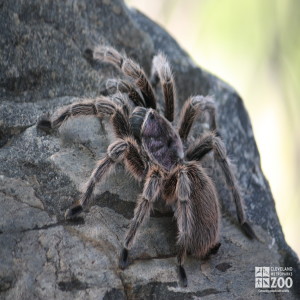Rose Haired Tarantula
[Grammostola rosea]

In the rose haired tarantula, the body is divided into two segments, the cephalothorax (a fused head and thorax) and the abdomen. The cephalothorax contains the mouthparts, the eyes and the legs. The abdomen contains the reproductive structures and the silk-producing structures. Almost all spiders breathe through organs known as book lungs. These are hollow leaf-like structures through which the blood flows, so that the blood can acquire oxygen to be distributed thoughout the body. The opening to the book lungs is located below the abdomen. All arachnids have piercing mouthparts called chelicerae. In spiders, the chelicerae are modified into fangs. At the base of the fangs are poison sacs that are used to subdue prey. The bite of the tarantula is not very painful or dangerous to humans, unless one has a severe allergy. A fully mature Rose Hair can reach approximately 5 inches (12.5 cm) with legs extended. They have a brown body, but the cephalothorax is colored a slight metallic pink, giving them their name. One way they protect themselves is by flicking abdominal hairs at the attacker. These hairs can irritate the skin, eyes and nose.
Location: Animals Formerly at Zoo
Share:
Range
The range of the rose haired tarantula is Chile, Bolivia, and Argentina.
Habitat
Rose haired tarantulas inhabit dry areas, such as deserts and scrubland.
Conservation Status
Primary Threats
Gestation
6 to nine weeks in the cocoon
Litter
50-200
Behavior
Tarantulas primarily use their fangs to catch and subdue prey, and only rarely in response to threats. Tarantulas do not build a web to trap prey. Also, they do not have good eyesight. They hunt at night, detecting their prey by touch. They may use a web, created by structures at the end of the abdomen called “spinnerets”, to act as a “trip wire” to alert them to the presence of prey. Since they cannot consume their prey whole, they must first liquefy the insides of their victims with a caustic mix of digestive enzymes.Reproduction
After their maturation molt, males hook and lock the female's fangs while they mate. After mating, males die within a couple months. The female must have recently molted in order to reproduce to make the sperm effective and so that it is not lost in the following molt. After mating the female makes a web for the eggs that become fertilized as they pass out of her body. The female then wraps the eggs into a ball and guards the egg sac.Wild Diet
Insects, arthropods, occasionally small frogs and lizards
Zoo Diet
Crickets
